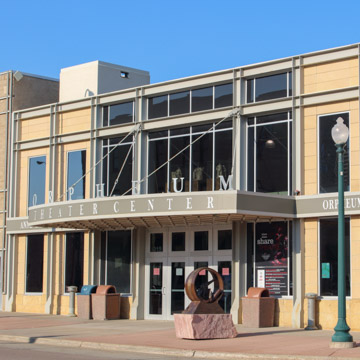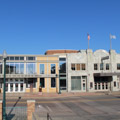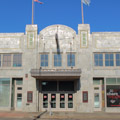You are here
Orpheum Theater Center
The Orpheum Theater Center, located on the main thoroughfare in downtown Sioux Falls, is the city’s oldest existing theater. The two-story building has a three-story fly tower at the rear, where the stage is located. The three-bay, polychromatic facade is clad in light gray terra-cotta that resembles marble, with a metal canopy over the central, recessed entrance. This center bay is flanked by slightly projecting pilasters that rise up to either side of a rounded parapet wall displaying the theater’s name; below this is a mounted sign also bearing the name “Orpheum.” Secondary entrances in the outer bays are recessed beside the large display windows of the ground-floor storefronts. Each outer bay has a flat-topped parapet wall with a horizontal yellow rectangular pattern made of terra-cotta tiles; this decoration is repeated at the top of the pilasters, where green squares are located inside a vertical yellow rectangle. Classical detailing is evident in the egg-and-dart molding of the cornice.
The interior includes a lobby, the auditorium and stage, dressing rooms, and a backstage area. Small apartments were once located above the storefronts. Marble wainscoting and tile floors adorn the lobby, and the ceiling and frieze of both the lobby and auditorium feature decorative murals. Originally a 1,000-seat vaudeville theater, Minneapolis architect J.J. Liebenberg remodeled the building in 1927 as a movie theater; some of the murals were painted over at this time. The theater eventually fell into disuse but was purchased by the Sioux Falls Community Playhouse in 1954.
Spitznagel Partners of Sioux Falls rehabilitated the theater in 1975, and stuccoed the exterior side and rear brick walls. In 1978, the theater expanded with a stucco-clad addition on the north side. An interior remodel that same year reduced the number of seats to 692.
In 1994 the City of Sioux Falls purchased a neighboring building, a bar and dance club known as the King of Clubs (1949), and leased it to the Sioux Falls Community Playhouse. Renamed the Anne Zabel Actor’s Studio, the two structures were connected the following year. Further renovations occurred in the 2000s, and the facility was renamed the Orpheum Theater Center, comprising the Historic Orpheum Theater, the Anne Zabel Actor’s Theater that can house 450 people, and a classroom space that can accommodate 100 people. In 2009, the Midwest Art Conservation Center restored the historic theater’s interior murals.
References
Writing Credits
If SAH Archipedia has been useful to you, please consider supporting it.
SAH Archipedia tells the story of the United States through its buildings, landscapes, and cities. This freely available resource empowers the public with authoritative knowledge that deepens their understanding and appreciation of the built environment. But the Society of Architectural Historians, which created SAH Archipedia with University of Virginia Press, needs your support to maintain the high-caliber research, writing, photography, cartography, editing, design, and programming that make SAH Archipedia a trusted online resource available to all who value the history of place, heritage tourism, and learning.



















